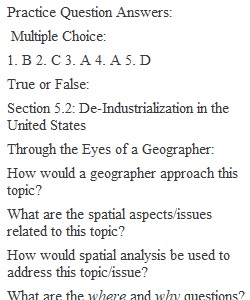


Q Section 5.2: De-Industrialization in the United States Through the Eyes of a Geographer: How would a geographer approach this topic? What are the spatial aspects/issues related to this topic? How would spatial analysis be used to address this topic/issue? What are the where and why questions? How can this topic be studied and analyzed using the five themes of geography? Overview: The period of de-industrialization (the spatial relocation of industry) brought an end to the Golden Age of industry in the United States. In a relatively short amount of time, cities of the traditional manufacturing belt (such as Detroit, Cleveland and Pittsburgh) went from vibrant, thriving, highly populated economic core areas, to blighted, abandoned shadows of the past. A complex set of circumstances led to the creation of what became known as the Rust Belt. Although many U.S. corporations continued to prosper in new locations, the cities and people of the traditional manufacturing belt were left behind to wrestle with a devastating set of social, economic, and urban crises that have largely continued to this day. Critical Thinking/Discussion Questions: 1. What is de-industrialization? Where and why did this occur? Where did industry relocate and why? 2. Discuss the impacts of de-industrialization on people of the traditional manufacturing belt region. What did this transformation mean for workers and their families? With whom did workers and their families typically become angry? Was this anger well placed? 3. How did once-thriving central cities of the traditional manufacturing belt become virtually abandoned and run down? What role did the owners of U.S. industry play in this urban decay? Practice Questions (Write Correct Answer in Blank): Multiple Choice: 1. ___ Beginning in the 1960s and into the 1970s, shifts in industrial location occurred both nationally in the U.S. and globally from: A) east to west B) north to south C) west to east D) south to north 2. ___ Between 1970 and 1984, the city of Detroit lost ____ percent of its population, leading to a loss of tax revenue: A) 5 B) 18 C) 33 D) 50 3. ___ Identify the “right to work” or “union free” state: A) Tennessee B) Ohio C) Illinois D) New York 4. ___ This city represents the western boundary of the traditional manufacturing belt: A) St. Louis B) Chicago C) Kansas City D) Indianapolis 5. ___ This term is used to describe the traditional U.S. manufacturing core after the effects of de-industrialization: A) ghost town B) megalopolis C) export enclave D) rust belt True or False: 1. ___ Infrastructure in many U.S. cities is hopelessly overloaded and/or life expired. 2. ___ During the last twenty years the United States has become less dependent on foreign imports. 3. ___ During the 1960s and 1970s U.S. industry tried to remain competitive by employing the latest manufacturing technology. 4. ___ Advances in global transportation and communication helped enabled de-industrialization to take place. 5. ___ Cities in the United States are characterized by a rapid rate of transformation.
View Related Questions